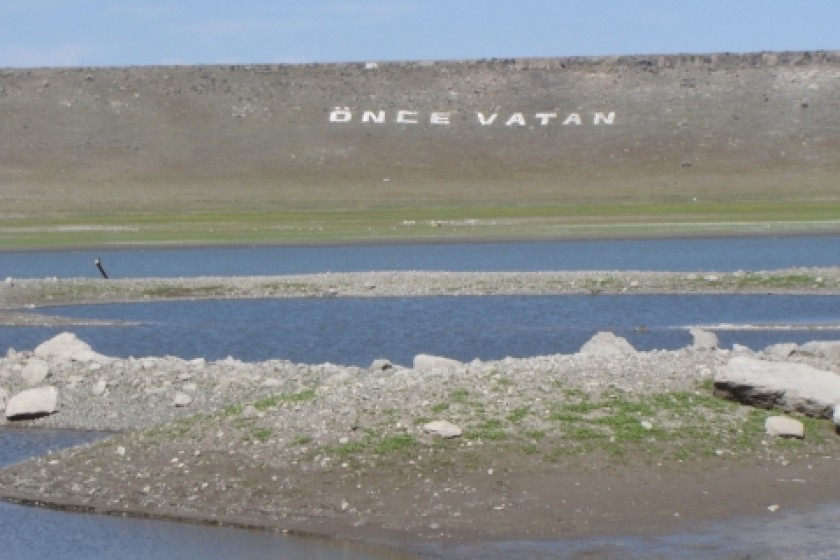
Residents of Jrapi Border Village of Two Minds Regarding Border Opening
When they started to build the Akhurian Reservoir along the Armenian border with Turkey, the residents of the village of Jrapi joked that they would soon become a seafaring community and might even raise a naval fleet. These were mere fleeting fancies, but the decision to construct the reservoir was a major government project and a part of the overall Soviet policy to expand and strengthen the existing border regions with neighboring nations.
After the reservoir was completed, six border patrol sailors from the Black Sea Fleet and a motor boat patrolled the waters for several years. Presently, patrols from the two countries monitor the waters from the bridge that spans the reservoir and surveillance occurs from the shores as well. 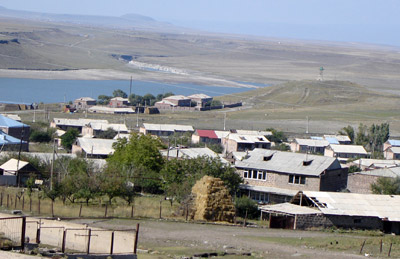 The village of Jrapi, in Shirak Marz, used to be divided into two parts. There are historical records of both Upper and Lower Jrapi that date back to the 10-11th centuries. A medieval caravanserai and fragments of a bridge built during the prosperous early period of the capital city of Ani still stood up until the construction of the reservoir.
The village of Jrapi, in Shirak Marz, used to be divided into two parts. There are historical records of both Upper and Lower Jrapi that date back to the 10-11th centuries. A medieval caravanserai and fragments of a bridge built during the prosperous early period of the capital city of Ani still stood up until the construction of the reservoir. 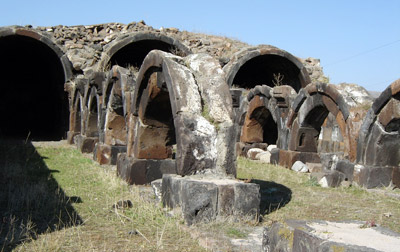 Both the caravanserai and the 18th century church in Upper Jrapi were relocated to a new site due to reservoir construction. The ruins of the bridge were submerged under the artificial lake. Jrapi residents say that when the level of the reservoir recedes enough they can visit the ruins of the bridge and be enthralled by its beauty. Sadly, such opportunities are few and far between. They say that this only happens during years of severe drought when the reservoir is tapped to irrigate the plain of Ararat. There was no comprehension of a border in this village up until 1947. The Akhurian River served as the border between Jrapi and the Turkish village of Kinak. At its widest, the river was only 4-5 meters and shallow enough to cross when water levels dropped. After the end of WW II, the village found itself encircled with barbwire and one needed a permit to enter or leave. Grandpa Rafik – “Carry a big stick when dealing with Turks”
Both the caravanserai and the 18th century church in Upper Jrapi were relocated to a new site due to reservoir construction. The ruins of the bridge were submerged under the artificial lake. Jrapi residents say that when the level of the reservoir recedes enough they can visit the ruins of the bridge and be enthralled by its beauty. Sadly, such opportunities are few and far between. They say that this only happens during years of severe drought when the reservoir is tapped to irrigate the plain of Ararat. There was no comprehension of a border in this village up until 1947. The Akhurian River served as the border between Jrapi and the Turkish village of Kinak. At its widest, the river was only 4-5 meters and shallow enough to cross when water levels dropped. After the end of WW II, the village found itself encircled with barbwire and one needed a permit to enter or leave. Grandpa Rafik – “Carry a big stick when dealing with Turks” 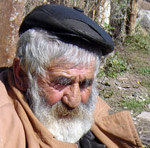 80 year-old Rafik Grigoryan doesn’t have many fond memories of that era. He doesn’t believe in making friends with the Turks. “When we were kids back during those years we’d go swimming in the Akhurian River. We’d round up the Turkish kids. They’d throw rocks at us. I still have the scars on my face. If it wasn’t for this beard I’d show you,” he says with a hint of anger, “Anyone who tries to make friends with the Turks better carry a big stick as well.” Mr. Grigoryan has spent his whole life in the village of Jrapi and opposes the opening of the border. “The Turks killed my grandfather’s brother Ghoukas in the Julfa wars and another brother up in the mountains here over a horse. It was a Karabakh horse and the jealous Turk took a fancy to it. The Turk is rotten to the core. They can never be trusted. You can sit down at the table and break bread with them but keep one eye open when you sleep in the same room. They can just as easily get it in their head to kill you that same night.” Mr. Grigoryan likes to read, especially historical novels. He is now rereading the novel “Bayazet” by Valentin Pikul. He keeps abreast of current events as well. He says that he and the other elders of the village often get together in a friend’s home to discuss the news of the day and exchange ideas. “My wife is very industrious but illiterate. One day we were discussing Karabakh in front of the house and saying that it was a grand victory for the Armenians. My wife blurted out – who needs Karabakh? I’m always telling her that she’s crazy that those are our lands where Turks and Azeris now live and that one day we’ll get it all back for sure,” he states. “The Turks will understand and finally recognize the Genocide. They will have to return our lands or pay compensation. Just like the Germans did with the Jews,” concludes Grandpa Rafik, “What’s important is that our leaders be intelligent and not illiterate like my wife. That would be a tragic mistake.” Others in the village are of two minds about the opening of the border with Turkey. There are those who recall the construction of the reservoir and remember that the Turkish and Armenian workers toiling side-by-side got along pretty well, even though the KGB kept fraternizing to a minimum. Engineer Spartak – “There are some good Turks as well” Spartak Mikayelyan, an engineer who’s worked for many years on the reservoir, smiled when I asked if he wanted the border to be reopened. He replied that for the past 30 years the border has been open for him. “Once a month we meet with our Turkish colleagues to plan for water releases. When we’re done we sit down and have a meal together.” Spartak claims that they have got pretty chummy over the years and ask how their families are getting along. He says that the border guards are present at these meetings, conducted in Russian, and that they haven’t had any problems so far. “There are some good Turks as well. There’s a proverb that says there is no village without its share of dogs. Let the border reopen. I fully support it.”
80 year-old Rafik Grigoryan doesn’t have many fond memories of that era. He doesn’t believe in making friends with the Turks. “When we were kids back during those years we’d go swimming in the Akhurian River. We’d round up the Turkish kids. They’d throw rocks at us. I still have the scars on my face. If it wasn’t for this beard I’d show you,” he says with a hint of anger, “Anyone who tries to make friends with the Turks better carry a big stick as well.” Mr. Grigoryan has spent his whole life in the village of Jrapi and opposes the opening of the border. “The Turks killed my grandfather’s brother Ghoukas in the Julfa wars and another brother up in the mountains here over a horse. It was a Karabakh horse and the jealous Turk took a fancy to it. The Turk is rotten to the core. They can never be trusted. You can sit down at the table and break bread with them but keep one eye open when you sleep in the same room. They can just as easily get it in their head to kill you that same night.” Mr. Grigoryan likes to read, especially historical novels. He is now rereading the novel “Bayazet” by Valentin Pikul. He keeps abreast of current events as well. He says that he and the other elders of the village often get together in a friend’s home to discuss the news of the day and exchange ideas. “My wife is very industrious but illiterate. One day we were discussing Karabakh in front of the house and saying that it was a grand victory for the Armenians. My wife blurted out – who needs Karabakh? I’m always telling her that she’s crazy that those are our lands where Turks and Azeris now live and that one day we’ll get it all back for sure,” he states. “The Turks will understand and finally recognize the Genocide. They will have to return our lands or pay compensation. Just like the Germans did with the Jews,” concludes Grandpa Rafik, “What’s important is that our leaders be intelligent and not illiterate like my wife. That would be a tragic mistake.” Others in the village are of two minds about the opening of the border with Turkey. There are those who recall the construction of the reservoir and remember that the Turkish and Armenian workers toiling side-by-side got along pretty well, even though the KGB kept fraternizing to a minimum. Engineer Spartak – “There are some good Turks as well” Spartak Mikayelyan, an engineer who’s worked for many years on the reservoir, smiled when I asked if he wanted the border to be reopened. He replied that for the past 30 years the border has been open for him. “Once a month we meet with our Turkish colleagues to plan for water releases. When we’re done we sit down and have a meal together.” Spartak claims that they have got pretty chummy over the years and ask how their families are getting along. He says that the border guards are present at these meetings, conducted in Russian, and that they haven’t had any problems so far. “There are some good Turks as well. There’s a proverb that says there is no village without its share of dogs. Let the border reopen. I fully support it.” 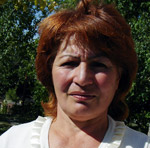 Hripsime Petrosyan, the Jrapi Municipal Secretary, also supports the idea of reopening the border. “I believe it’s better to have a bad peace rather than a good war. Shirak Marz is in a pretty poor state without the border being open. It’s a poor region. At least there will be the possibility of economic gain when it opens. The financial situation of people here will stabilize, jobs will be created and trade will pick-up,” she argues. Bees and pigs illegally cross the river into Turkey Hripsime says that her grandfather’s house was on the bank of the Akhurian River. One day her grandmother noticed that her swarm of honey bees had crossed over to the other side. Fearing that she’d lose her precious bees and honey, the grandma picked up a few trays from the hive and crossed the river, winding up in the Turkish village of Kinak. A couple of Russian border guards soon arrived and arranged to take her back. Several Turkish villagers helped her transport the bees back. Villagers relate that up until the 1970’s, before the reservoir was built, it was mostly farm animals that crossed back and forth over the shallow river. There’s an amusing tale about a pig belonging to an Armenian villager that crossed over to the Turkish side. Seeing the religiously proscribed animal, the Turks surrounded it but didn’t harm it. Russian border guards went and confiscated the animal but didn’t return the porker to its owner, arguing that it might have been infected and needed to be slaughtered. Anahit Tovmasyan, who came as a bride to Jrapi, is adamantly opposed to the border being reopened. “Let them first recognize the Genocide. Only then can the border be opened. Our writers, Teryan, Charents or Shiraz, could give you a much better answer to that question,” she replies. “You know, it’s pretty tough to live in a village where your lands lay on the other sight in full view but you’re not allowed to cross over.”
Hripsime Petrosyan, the Jrapi Municipal Secretary, also supports the idea of reopening the border. “I believe it’s better to have a bad peace rather than a good war. Shirak Marz is in a pretty poor state without the border being open. It’s a poor region. At least there will be the possibility of economic gain when it opens. The financial situation of people here will stabilize, jobs will be created and trade will pick-up,” she argues. Bees and pigs illegally cross the river into Turkey Hripsime says that her grandfather’s house was on the bank of the Akhurian River. One day her grandmother noticed that her swarm of honey bees had crossed over to the other side. Fearing that she’d lose her precious bees and honey, the grandma picked up a few trays from the hive and crossed the river, winding up in the Turkish village of Kinak. A couple of Russian border guards soon arrived and arranged to take her back. Several Turkish villagers helped her transport the bees back. Villagers relate that up until the 1970’s, before the reservoir was built, it was mostly farm animals that crossed back and forth over the shallow river. There’s an amusing tale about a pig belonging to an Armenian villager that crossed over to the Turkish side. Seeing the religiously proscribed animal, the Turks surrounded it but didn’t harm it. Russian border guards went and confiscated the animal but didn’t return the porker to its owner, arguing that it might have been infected and needed to be slaughtered. Anahit Tovmasyan, who came as a bride to Jrapi, is adamantly opposed to the border being reopened. “Let them first recognize the Genocide. Only then can the border be opened. Our writers, Teryan, Charents or Shiraz, could give you a much better answer to that question,” she replies. “You know, it’s pretty tough to live in a village where your lands lay on the other sight in full view but you’re not allowed to cross over.”  Anahit’s 81 year-old mother-in-law Siranuysh sees things differently. Grandma Siranuysh wants the border to reopen. “Once it opens, I will immediately set off for Moush. Our people hail from around Moush. I want to go and see our village. Let them open the damn border so I can go and see our ancestral village before I die,” she says. On the Turkish side of the border, on two lofty mountains opposite Jrapi, there are two inscriptions painted in Turkish. We were able to photograph one that reads “ONCE VATAN”, which translated means Turkish land or home. Local villagers translated the other large inscription as “He is happy who was born a Turk”. They say that this too is politics. When the sky is clear every Armenian, like it or not, sees these Turkish inscriptions. Perhaps the Turks have thought - if the eye gets used to this, so too will the mind as well.
Anahit’s 81 year-old mother-in-law Siranuysh sees things differently. Grandma Siranuysh wants the border to reopen. “Once it opens, I will immediately set off for Moush. Our people hail from around Moush. I want to go and see our village. Let them open the damn border so I can go and see our ancestral village before I die,” she says. On the Turkish side of the border, on two lofty mountains opposite Jrapi, there are two inscriptions painted in Turkish. We were able to photograph one that reads “ONCE VATAN”, which translated means Turkish land or home. Local villagers translated the other large inscription as “He is happy who was born a Turk”. They say that this too is politics. When the sky is clear every Armenian, like it or not, sees these Turkish inscriptions. Perhaps the Turks have thought - if the eye gets used to this, so too will the mind as well.
 Videos
Videos Photos
Photos




Write a comment